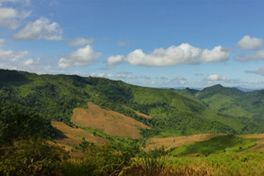 Shifting cultivation pattern found in the mountains of Northern Laos. The landscape is characterized by fragments of primary forest, secondary forest, fallow vegetation, and upland rice, and more recently also maize fields.
Photo: CDE
Shifting cultivation pattern found in the mountains of Northern Laos. The landscape is characterized by fragments of primary forest, secondary forest, fallow vegetation, and upland rice, and more recently also maize fields.
Photo: CDE
The incomes of farm households in developing countries are notoriously low and uncertain. Coping strategies might include relying on safety nets such as forests and fallows for food and non-timber products, varying crops and farming patterns, cashing in on savings, selling family assets, migrating elsewhere in search of work, relying on remittances and wage labour, and accessing informal forms of insurance and credit. This project in cooperation with CIFOR asks whether the structure of environmental incentives (as credit, insurance, or payments) influences land use behaviour.